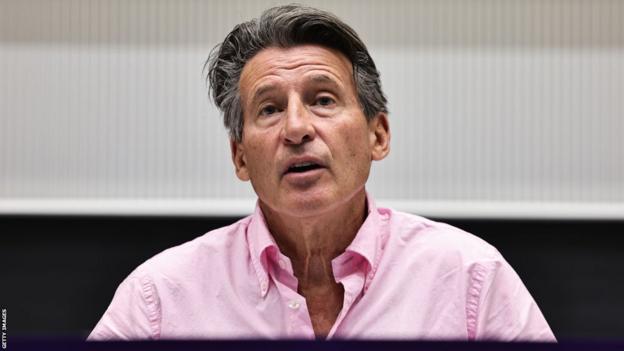

World Athletics has banned transgender female athletes from competing in the female category at international events.
The governing body’s president, Lord Coe, said no female transgender athlete who had gone through male puberty would be permitted to compete in female world ranking competitions from 31 March.
A working group will be set up to conduct further research into the transgender eligibility guidelines.
“We’re not saying no forever,” he said.
Under previous rules, World Athletics required transgender female athletes to reduce their amount of blood testosterone to a maximum of 5nmol/L, and stay under this threshold continuously for a period of 12 months before competition.
Lord Coe added the decision was “guided by the overarching principle which is to protect the female category”.
He noted that there are currently no transgender athletes competing internationally in the sport.
The World Athletics Council also voted to reduce the amount of blood testosterone permitted for athletes with differences in sex development (DSD), such as South Africa’s Caster Semenya.
DSD athletes will be required to reduce their blood testosterone level to below 2.5 nanomoles per litre, down from five, and must remain under this threshold for two years in order to compete internationally in the female category in any track and field event.
Under previous regulations, DSD athletes were only restricted in events ranging from 400m to a mile.
Interim provisions will be introduced for DSD athletes already competing in previously unrestricted events, requiring them to suppress their testosterone levels below 2.5nmol/L for a minimum of six months before they are allowed to compete again.
“Decisions are always difficult when they involve conflicting needs and rights between different groups, but we continue to take the view that we must maintain fairness for female athletes above all other considerations,” said Lord Coe.
“We will be guided in this by the science around physical performance and male advantage which will inevitably develop over the coming years. As more evidence becomes available, we will review our position, but we believe the integrity of the female category in athletics is paramount.”
The Council agreed to set up a working group for 12 months to “further consider the issue of transgender inclusion”.
An independent chair will lead the group, while it will also include up to three council members, two athletes from the Athletes’ Commission, a transgender athlete, three representatives of World Athletics’ member federations and representatives of the World Athletics health and science department.
It will consult specifically with transgender athletes, as well as review and commission research and put forward recommendations to the Council.
‘Little support’ for previous preference – World Athletics
As recently as January, World Athletics said its “preferred option” was to continue to allow transgender women to compete in the female category but to tighten the sport’s eligibility rules, still using testosterone limits as the basis for inclusion.
It had proposed that transgender women would have to reduce their blood testosterone level to below 2.5nmol/L for two years, bringing it in line with amendments made last year by the UCI, cycling’s world governing body.
However, World Athletics said there was “little support” for this option when it was presented to stakeholders, who included member federations, athletes, coaches, and the International Olympic Committee (IOC), as well as representative transgender and human rights groups.
Many argue that transgender women should not compete in elite women’s sport because of any advantages they may retain – but others argue that sport should be more inclusive.
The debate centres on the balance of inclusion, sporting fairness and safety in women’s sport – essentially, whether transgender women can compete in female categories without an unfair advantage.
The IOC’s framework on transgender athletes – released in November 2021 – states that there should be no assumption that a transgender athlete automatically has an unfair advantage in female sporting events, and places responsibility on individual federations to determine eligibility criteria in their sport.
More to follow.
